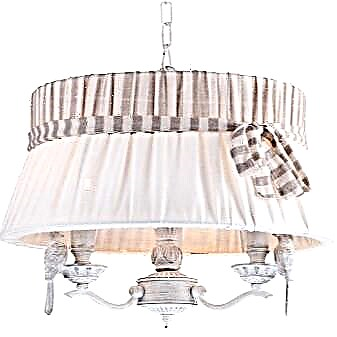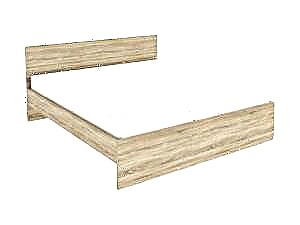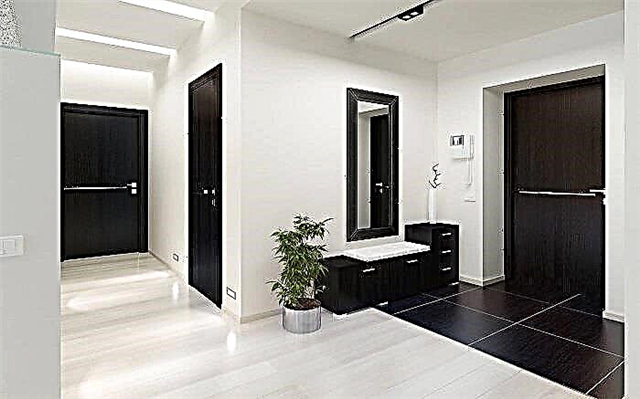Which linoleum to choose for the bathroom? The question is acute, especially when it comes to designing a bathroom “for yourself”, when you want a convenient, practical, and at the same time, economical solution for the floor. In the article we will figure out whether this is the right decision, use linoleum, determine all the pros and cons of laying it in the bathroom.

The possibility of using linoleum in a room with high humidity and insufficient ventilation is, at first glance, an irrational idea. However, modern coatings may not cope with such tasks. Subject to certain conditions, which we will discuss below, linoleum will serve faithfully for several years. What are these conditions? It's simple: you should strictly observe the technology of laying the material, well, not every type of linoleum is suitable for the bathroom.
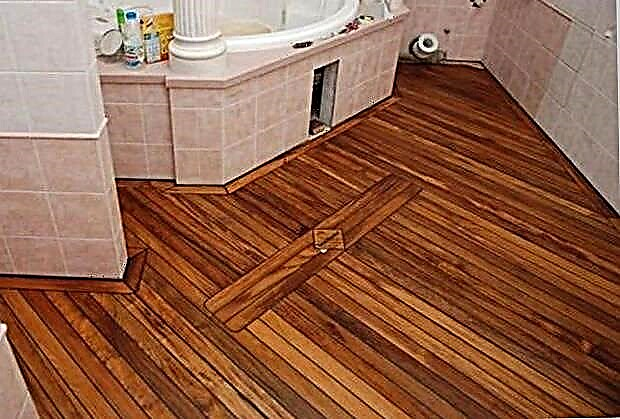
Properly selected linoleum for the bathroom can look more advantageous compared to even expensive tiles
There is no specific type of bath cover. To choose the material for the bathroom, you need to consider a number of parameters.
- The only suitable material from which linoleum is made is PVC. Definitely not worth choosing alkyd, colloxylin and rubber bases. It is also not recommended to use marmoleum for several reasons: although the material is waterproof, its inner layers can accumulate moisture, it is fragile and short-lived.
- For the bathroom, only a homogeneous type of linoleum is suitable. This means that there should be no substrate in its structure, since it is able to absorb water, which is contraindicated when used in conditions of high humidity.
- Do not forget about wear resistance. Only commercial and semi-commercial material with a polyurethane protective layer is able to withstand harsh conditions for several years.
- To put in the bathroom you need a special anti-slip linoleum. These types are not very many, but they exist. Their main difference from other models is the presence of corundum chips in the surface layer. When choosing a coating, pay particular attention to its designation. The degree of anti-skid has a Latin designation in the form of the letter R. The numbers after the letter are nothing more than the degree of anti-skid. To date, 4 parameter classes have gained distribution: from R8 to R13. The best option for the bathroom is R10. Such models have a higher cost.

Now let's talk about the advantages and disadvantages of using linoleum in the bathroom.
Linoleum in the bathroom: the pros and cons
pros
- Cost. This is the most affordable option for flooring in the toilet or bathroom.
- Moisture resistance. Properly selected material is able to provide complete protection of the floor from moisture.
- Huge selection of texture and color. The presence of a wide range of linoleum in stores and markets is one of the most important advantages of this type of coating. You are sure to find a suitable option for your bathroom, which can complement an existing interior or bring your own “highlight” to it.
- Easy styling. To lay linoleum in the bathroom is possible for anyone who knows how to hold a hammer in their hands.
- Durability. The right choice of coating and its proper operation is the key to a long life of the material.
- Tactile sensations. You must admit that it is much more pleasant to get up on warm linoleum after taking a shower than on cold ceramic tiles.
- Easy to care. An ordinary wet rag and no more will help to make the material clean.
Minuses
- The risk of mold and mildew is perhaps the main drawback, due to which you should never think about choosing a coating for the bathroom. Antibacterial additives are antibacterial additives, but if there is deformation or violation of the surface layer and moisture gets there, the risk of mold or fungus is still present.
- The ingress of water on the surface of the floor increases its slippiness, especially linoleum. The problem can be solved by placing a rubber mat in front of the bathroom.
We voiced all the nuances, all the pros and cons of laying linoleum in the bathroom. Next: the choice is yours!
Features of the use of linoleum in the bathroom
It is worth noting that linoleum has never been appreciated as a floor covering for rooms with constantly high humidity. None of the manufacturers existing today can boast of material intended directly for covering floors in sanitary units.
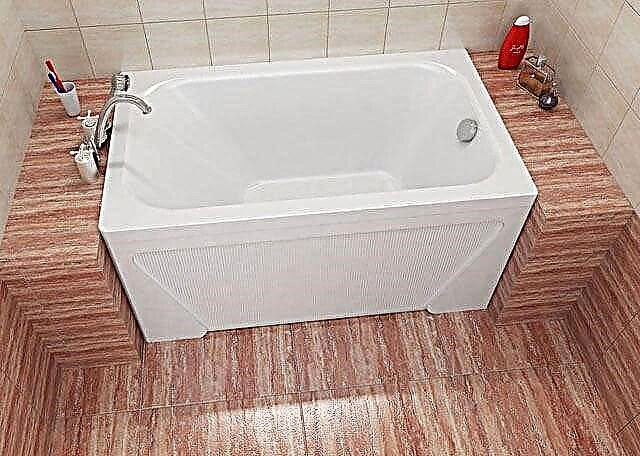
It is important that linoleum in the bathroom and toilet has the following features:
- high moisture resistance
- the absence of a substrate with pores or nap, which may interfere with the removal of moisture,
- the surface should not be slippery, which means that it is necessary to select a special type of material or means for processing linoleum that eliminates the effect of sliding,
- the presence of antibacterial treatment that protects the surface from the appearance of microorganisms and fungi.
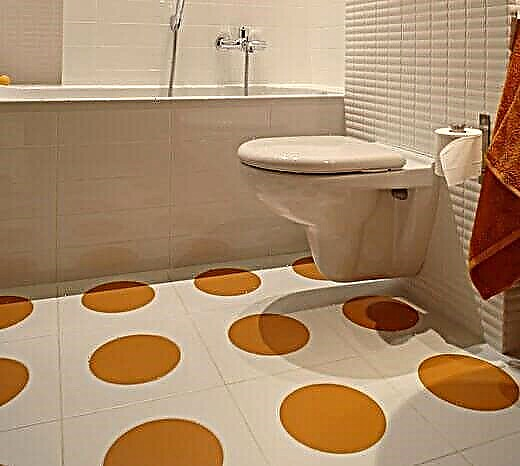
In order to ensure high-quality and durable flooring, not only moisture-resistant linoleum for the bathroom is needed, but also full compliance with the installation technology:
Laying linoleum on a wooden floor
The process of leveling the cement floor has been repeatedly described and it will not cause difficulties for a master who understands the construction process. As for the processing of ceilings in a wooden house, it will take more effort and time to create a quality foundation for laying linoleum.
Initially, many wooden buildings are simply not equipped with a bathroom. Owners most often rebuild a kind of plumbing unit in the outbuildings. They can only understand whether it is possible to lay linoleum in the bathroom and how to do it (more: "How to lay linoleum on a wooden floor with your own hands").
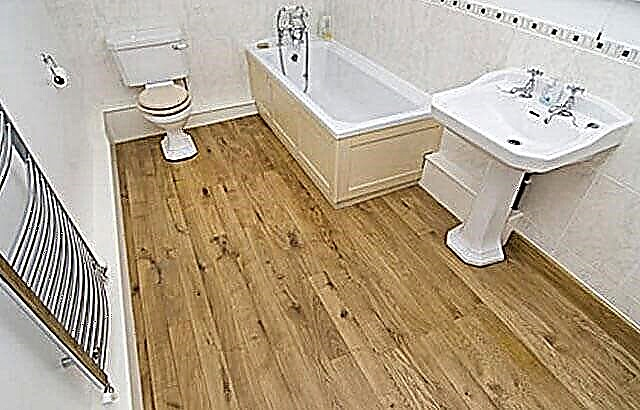
In fact, the sequence of actions in this case is very simple:
- the wooden coating must be impregnated with antiseptics, which will preserve the wood in the absence of ventilation due to the tightness of the laid material,
- any unevenness on the surface of the floor beams can lead to deformation of linoleum, and therefore it should be covered with an ideally even sheet of chipboard or OSB,
- linoleum must be allowed to lie down for a day, and then it must be glued, not forgetting about the 5-cm spacing on the walls (more in detail: "How long and how much linoleum is laid down"),
- joints between adjacent sheets of material should be hidden. To do this, you can use a building hair dryer or Cosmofen glue.
According to the norms for the construction of residential premises, there is a requirement for the floor level in the sanitary unit, and it must be lower than the same surface in other rooms of the house. If such a discrepancy arises, then you can eliminate the risk of accidental liquid from the bathtub entering the neighboring rooms with the help of an overestimated threshold that will clamp the linoleum sheet under the door.
If you take into account all the features of wooden floors, then we can safely say that linoleum is the cheapest floor covering that resists moisture well and has a long service life. Moreover, such a surface looks aesthetically pleasing that it is impossible to distinguish it from traditional facing materials by photo or at first glance.
Naturally, for a better design, you need to buy waterproof linoleum with a texture that mimics any of the alternative coatings.

Also, many owners are interested in whether it is possible to put linoleum in the bathroom, which is equipped with its own floor heating system. Naturally, this is permissible, but a special coating should be used, which has the corresponding marking, and the maximum temperature bar for heating the surface is prescribed in the documents for this material. It is also worth considering that linoleum has poor thermal conductivity and a much larger amount of energy will have to be spent to heat the room.
Owner reviews
Many owners who have already chosen linoleum as a floor covering for a plumbing unit in a wooden house left reviews on the Internet.
Naturally, there are many opinions and each person has his own opinion on this issue, but most of them agree on a number of points:
- the material is the cheapest among alternative coatings matching the characteristics,
- the laying process is very simple: you just need to stock up on the material itself, a high-quality adhesive mixture and an algorithm of actions, from which you should not deviate, since this is fraught with consequences when operating the floors,
- the service life reaches 10 years, and can lie even longer with careful use. At the same time, the coating maintains tightness and practically does not lose its appearance. Types of coating with a texture applied over the entire thickness are very practical. Even with uneven scuffs, in the photo and during visual inspection, they will look like new,
- to avoid injuries, you should purchase a rough coating or treated with a special composition against the sliding effect,
- in the absence of underfloor heating, linoleum can be cold, therefore, species that better store heat and can be used without a heating system should be acquired.
From the foregoing, we can conclude that the reliability of the coating cannot be guaranteed if you deviate from a clear algorithm of actions when laying linoleum. Use this material should be in cases where it is not possible to lay tiles, porcelain stoneware, parquet and other coatings. If there are certain difficulties with laying linoleum, you should seek help from professionals who will take on all the steps, starting with the purchase of building materials and ending with checking the finished coating.
Features, advantages and disadvantages
Yes, this material is rarely found in bathrooms. And the very expediency of its use there causes fierce debate. Professionals know that not any type of linoleum is suitable for a humid environment, and that the installation technology is not the same as in other rooms. However, there are no insurmountable obstacles to the use of such a coating. There are no special brands or varieties of linoleum, which would be designed specifically for the bathroom.
Of the currently commercially available coating types, only PVC-based options are suitable for this room. Some experts also say that you can use marmoleum. But one should not fully trust such statements. Yes, marmoleum is of high quality, but its main layer can absorb water and steam. In addition, this material is more fragile than PVC-based products.

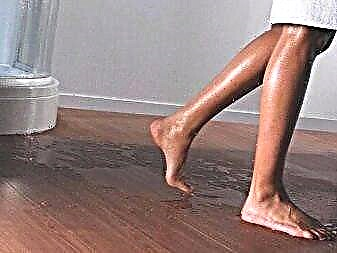
To decide whether to use linoleum in the bathroom, it is necessary to clearly present its positive and negative qualities. By using such a material, the absolute impermeability of the floor to water can be guaranteed. Of course, if the coating is chosen correctly and laid exactly according to technology. Linoleum decoration is also attractive because of its cheapness. Only paint is more accessible, and then not of any brand.

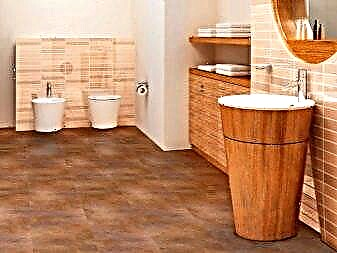
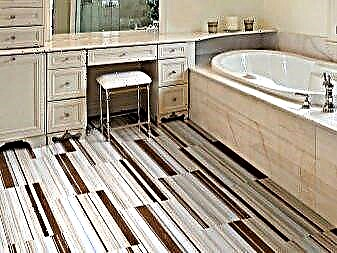
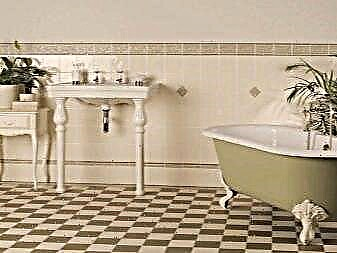
Immediately after laying out the linoleum rolls and securing them, you can begin to use the bathroom. No need to wait for something to dry, grab or stick. In addition, linoleum can be decorated with a wide variety of materials. There are options for wall rolls with imitation:
The second option is especially attractive, because it is not very rational to use natural wood to finish the bathroom. Laying linoleum with your own hands is not difficult compared to installing ceramic tiles. Only some stages require certain skills.
The choice of linoleum for the bathroom
There is no special brand of material for bathrooms. Choosing linoleum in the bathroom, you need to consider a number of parameters that make it desirable or undesirable for installation in a room having such specific conditions.
Base material. Of all the existing types of material (alkyd, colloxylin, rubber, etc.), only PVC linoleum is definitely suitable for a bathroom. You can find recommendations for using marmoleum, but these tips should be treated with caution.

Natural linoleum or marmoleum is a very high-quality material. They make it from natural components - jute fiber, chopped wood, linseed oil, various additives. But some coating parameters impose restrictions on its use. The top layer of marmoleum is waterproof, but what’s under it can absorb water. In addition, the material has increased fragility in comparison with PVC linoleum. Therefore, to decide whether a particular brand of marmoleum is suitable for laying in the bathroom or not, you must definitely familiarize yourself with the recommendations of its manufacturer.
Structure. Linoleum for the bathroom should be homogeneous, i.e., the substrate should be absent. At its core, it is a sponge that absorbs moisture, which means that its presence in the wet conditions of the bathroom is strictly contraindicated.
Wear resistance. This is a very important parameter.
If linoleum in the bathroom is laid as a permanent, not temporary coating, it is necessary to use not household, but commercial or semi-commercial material, which has a high-density protective layer of polyurethane on top.
Anti-slip properties. One of the main disadvantages of linoleum in the bathroom is its slippiness, especially wet. This is a serious security issue. Special non-slip coating grades are produced, the surface layer of which contains corundum chips.
According to DIN 51130, the degree of anti-skid is indicated by the letter R with a number. According to this parameter, linoleum is divided into 4 classes - from R8 to R13. For bathrooms it is recommended to use R10. But anti-slip grades of material are more expensive. In addition, in the presence of moisture on the surface, anti-slip is greatly reduced. Therefore, before buying special linoleum, you need to think carefully about whether it is worthwhile to lay an expensive non-slip coating in your bathroom or to put a cheap PVC linoleum, covering it in rubber-resistant areas that are problematic from a safety point of view.
Color, texture. These parameters do not affect performance and should be determined taking into account the overall design of the bathroom and personal preferences.
Antibacterial additives. Since the material is operated in humid conditions, it is desirable that antibacterial substances be present in its composition.
Bathroom in a wooden house - how to equip it and finish read in our publication.
You can find out everything about choosing a door to a bathroom from this article.
The benefits of using linoleum in the bathroom
What arguments make linoleum for the bathroom an acceptable option? There are a lot of them.
- An opportunity to provide absolute moisture tightness of a floor.
- Cheapness.After paint, linoleum is one of the cheapest materials, and certainly cheaper than ceramic tiles and a moisture resistant laminate.
- Beautiful appearance. The surface of linoleum can with great accuracy imitate various materials - wood, tile, stone, laminate. Having spent a relatively small amount, you can ensure complete harmony of the flooring with any material present in the interior. This is a very serious argument in favor of choosing linoleum in the bathroom.
- The laying technology is relatively simple compared to ceramic tiles (although some of its steps require a certain skill).
- Durability - subject to the right choice.
- The sound insulation increased in comparison with a tile.
- Comfort for bare feet. An important property for linoleum in the bathroom, which is not as warm as wood, but much warmer than ceramic tile.
- Ease of care. Rare material can be compared in this regard with linoleum. It is enough to walk on it with a damp cloth, and its surface sparkles with cleanliness again.

- The main one is the danger of the formation of fungi and mold under the coating if water has penetrated there. It can no longer evaporate from under moisture-proof material.
- The slippery of the surface, especially if water gets on it.
- Shorter than tile life. But this disadvantage can be significantly reduced by using commercial material.
Laying linoleum on the screed
The main requirement for laying linoleum in the bathroom is to guarantee the exclusion of moisture under the coating. To do this, it is necessary to reliably seal the perimeter of the linoleum carpet and all the joints on it, and to prevent the formation of air cavities under it.
High demands are made on the condition of the screed. Firstly, by the time of installation it should be completely dry. Secondly, its surface should be perfectly flat. A feature of linoleum is that it accurately repeats the shape of the base, if there are bumps on it, they will certainly be displayed on the coating. And sooner or later in these places its break and destruction will begin.
Before you lay linoleum in the bathroom, it must be kept unfolded on a flat surface for at least a day. This is necessary for him to take the form in which he will be operated.
It is advisable to lay it in one whole piece for plumbing that has been cleaned for a while, although in practice this can by no means always be provided. But, in general, the fewer joints, the higher the guarantee of tightness.
If the joints cannot be avoided, then cutting and fitting in their places is carried out according to known technology. Strips of material are superimposed on top of each other with overlapping, along which the cut is made. After removing the cut off parts, the edges of linoleum fit exactly together.
Sealing joints can be done cold (using glue) or hot welding. The latter is performed by a special apparatus with a heated adhesive cord, which fills the joint, forming a homogeneous waterproof joint.
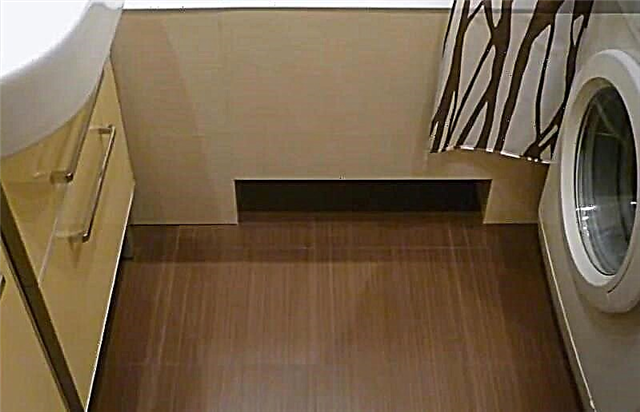
It is recommended to lay linoleum in the bathroom with bending the edges to the wall, so that the coating forms a kind of trough that can accommodate a significant amount of spilled water. The adhesive used must be moisture resistant.
Bonding is done in two steps. Initially, one half of the linoleum rolls up to the middle of the room. An even layer of glue is applied to the screed with a spatula, after which the roll is rolled with simultaneous pressing and squeezing out air and excess glue from under the carpet from the middle to the edge. This is convenient to do with a hard rubber roller. In some cases (when the instruction requires it), the glue is applied not only to the base, but also to linoleum.
Then the same operation is repeated with the second half of the floor.
The design of the interface between the floor and the wall
This is the most important place. It can be issued in several ways.
- 1 way. To ensure a smooth transition of linoleum from floor to wall, a triangular plastic baseboard is glued to their joint. After laying the material, a soft border is glued to its upper edge located on the wall, which provides sealing of the joint.
- The second, more technologically advanced method involves the use of special flute skirtings. They consist of 2 or 3 elements, each of which performs its function. One fits into the corner for a smooth bend of linoleum. Another, which is a plinth, closes and seals the wall edge of the coating. The use of flute skirting boards not only facilitates laying, but also provides high perimeter tightness.
Sometimes, in order to simplify the work, linoleum in the bathroom is not bent on the wall, but laid with a small (several mm) non-access to it. The joint between the wall and the edge of the coating is filled with glue. Given that the main waterproofing of the bathroom is usually done with the entrance to the wall, this simplification does not affect too much the overall tightness of the floor.
To dry, glue usually takes about a day or a little more.

Laying linoleum on a wooden base
If with respect to stone foundations it is possible to talk about the more or less expediency of using linoleum, then for wooden floors the picture changes to the opposite - linoleum floor becomes one of the most preferred options.
The wooden base is subject to a natural change in size and shape, and it is difficult to find a better material to compensate for these changes than linoleum.
The basic requirements for laying linoleum on a wooden floor are the same as for stone floors. The material must be laid on a completely flat base. For its preparation, wooden plate materials (plywood, oriented particle boards or particle board) are used, laid on the rough floor. All wooden structural elements are recommended to be treated with an antiseptic.
Sticker coating and sealing joints is made according to the same rules as for stone foundations.
Linoleum in the bathroom is a perfectly acceptable option, having many advantages. It is only necessary to correctly choose the brand of material and correctly lay it.
Material Features
To begin with, it is worth mentioning that linoleum is used in the bathroom not only for flooring. Often this material is used for walls. This option is an excellent budget replacement for traditional ceramic tiles, which is most often used to design a bathroom.
Basically, single-layer coatings are used for decoration. The peculiarity of this type is the absence of a felt base or other substrate. It is known that such layers in the material absorb moisture quite easily, which leads to a loss of appearance and performance.
To design the bathroom, waterproof linoleum is used. Due to the presence of a protective coating, the material retains its appearance for a long time, does not deform under the influence of moisture.
The same point applies to linoleum, which is used for walls. A non-slip coating is used to finish the bathroom floor. This point is especially important, since in the opposite case, a person can easily slip on a surface moistened with water. Therefore, for the bathroom, it is worth choosing linoleum having a ribbed base.


Advantages and disadvantages
Like any floor covering, linoleum for the bathroom has its own advantages and disadvantages.
First you need to list the main advantages of this type.
- Ease of installation. The work does not take much time and effort, since linoleum lends itself well to laying on different types of surfaces,
- Affordable cost. Compared to other species, this option is the most economical,
- Coating Integrity. In the process of laying, you will not have to close up the seams, as it happens when installing ceramic tiles.
Another advantage of linoleum is a wide color palette. Manufacturers produce a wide variety of options that harmoniously fit into both the classic and modern interior of the bathroom.
In addition, linoleum does not need special care. If the ceramic tile is quickly contaminated, especially in the area of joints, then with this coating there are no such problems. In addition, linoleum does not need to be cleaned with special tools.
The material, especially the wall type, has a high level of moisture resistance. Please note that this point applies only to homogeneous coatings.
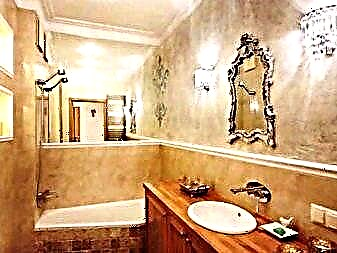
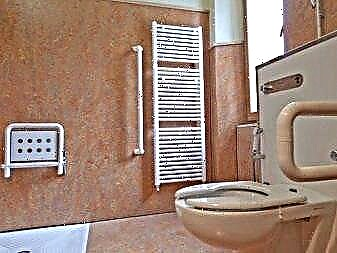
As for the shortcomings, they are also available.
For example, many people use linoleum with a fabric base to decorate the bathroom, which is a huge mistake. In a short time, the coating collects a fairly large amount of moisture underneath, which may cause mold or an unpleasant odor.
Compared to more expensive types of flooring, linoleum is not very resistant to deformation. Under the weight of the overall plumbing, the material begins to squeeze.
To avoid such a problem, professionals recommend the use of special rubber pads.
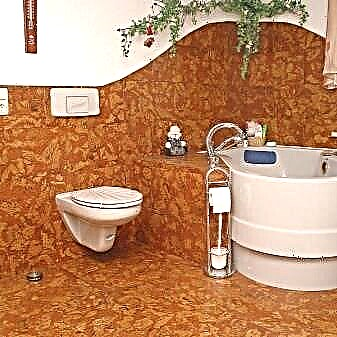
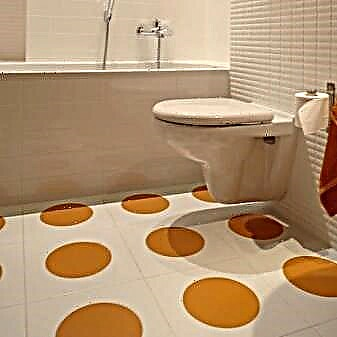
How to choose?
In choosing linoleum for decorating the bathroom, several important features must be taken into account. It is worthwhile to understand that you are buying material that will be operated at temperature extremes and increased humidity.
In addition, the coating will often succumb to various chemicals. A prerequisite is the choice of moisture-resistant material for the bathroom. This applies to both the wall appearance and flooring.
If you do not plan to make major repairs in the next 5-6 years, then give preference to a material with high wear resistance. These properties have a semi-commercial and commercial appearance.
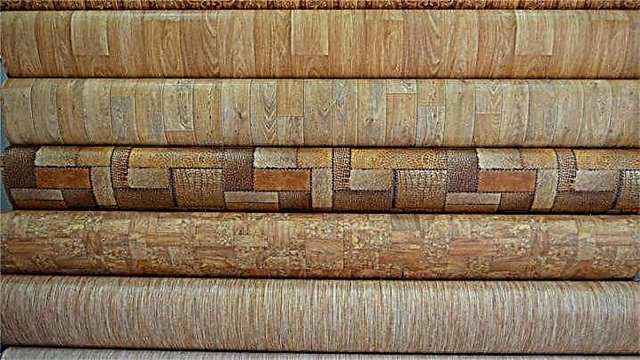
The next decisive factor is the presence of an additional insulation layer. As noted above, it is best to choose homogeneous thickened coatings. Particular attention should be paid to this if the system was used to finish the bathroom system "warm floor". In this situation, you can consider several options for linoleum.
For decoration, you can use marmoleum (natural look), which belongs to the group of environmentally friendly materials, but it should be borne in mind that the coating is characterized by low water resistance.
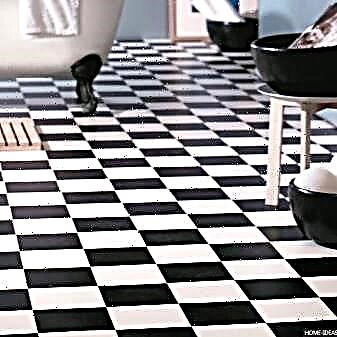

When choosing a material, pay attention to the fact that the options for floor and walls are somewhat different from each other in technical characteristics. The difference between these two types is the degree of wear resistance. The material for wall decoration is slightly thinner, since it does not lend itself to a large load during use.
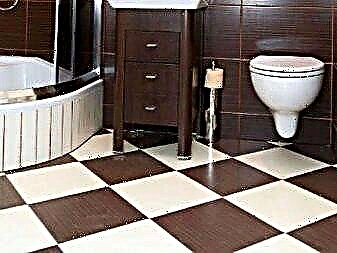
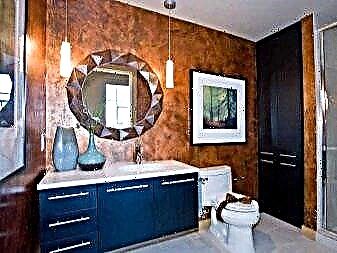
How to lay linoleum?
If you intend to put linoleum on your own in the bathroom, you should first familiarize yourself with some features regarding the installation process.
Your main task is to prevent the penetration of moisture under the material.
- Before you start laying linoleum, you must dismantle the old canvas. If defects are present on the surface, level the base. Most often, this problem occurs when laying linoleum in a wooden house. It is a little easier to work with a concrete base.
- After removing the old canvas, roll new linoleum onto the surface. Pay attention to the fact that the material should slightly "climb" onto the walls.

For fastening the canvas, it is best to use special clamping skirting boards. This will not only help to tightly fix the material, but also bring aesthetics into the interior.

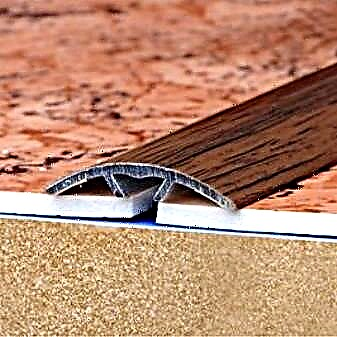
- It is preliminary recommended that the material be left to rest for 2-3 days before laying. During this time, the canvas will take shape. Then you can fix the coating on the base.
- To make the process easier, it is recommended to unscrew one part of linoleum and apply glue to the floor. The canvas is pressed tightly using a rubber roller. Make sure that no excess adhesive remains after fixing. Similarly, fix the second part of the canvas. After the end of the process, it is necessary to wait until the coating has completely dried.
Keep in mind that for laying linoleum it is not recommended to use adhesive products that dissolve in water. An ideal choice would be a chloroprene based formulation.

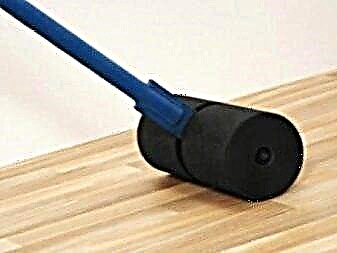
- Often for laying, an incomplete canvas is used. In this case, a mandatory installation step is to perform sealing. For these purposes, cold or hot welding is used. The selected method is used to close the gaps that appeared during communications.

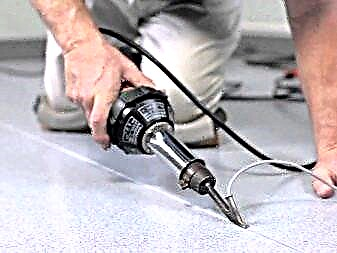
Reviews
In the acquisition of high-quality flooring for the bathroom will help customer reviews and experts. Basically, consumers recommend choosing materials from trusted, trusted companies.
One of the world leaders in sales is the company Tarkett. Basically, the company specializes in creating PVC coatings. The company presents to customers various types of linoleum. Household roll floors are especially popular. But for the decoration of the bathroom it is best to choose semi-commercial Tarkett linoleums.
No less popular among buyers are flooring products from the company Grabo. Particular attention must be paid to anti-slip linoleum. This option will be the perfect choice for decorating the bathroom.
Buyers note that thanks to a wide variety of color solutions, it is easy to determine the optimal look for any interior. Coatings have good wear resistance. In addition, linoleum has anti-slip embossing. To avoid deformation during use, the presence of fiberglass between the layers helps.
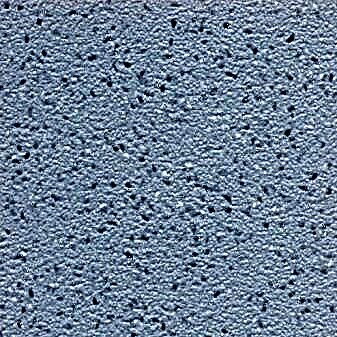
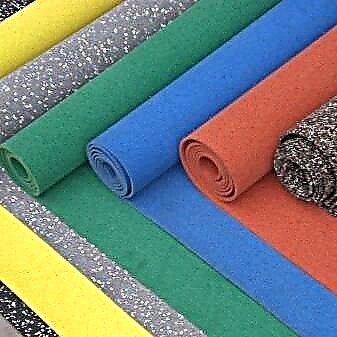
Do not lose sight of high-quality natural coatings. These options are released by the company. Forbo. The company makes natural linoleum designed for any type of premises. It should be noted that Forbo coatings are presented in several classes, so that customers have the opportunity to choose the option, focusing on different degrees of load.
Consumers note that in comparison with many natural species, these coatings have perfect stability and absolute environmental friendliness, but they are unhappy that high demands are placed on the laying base.
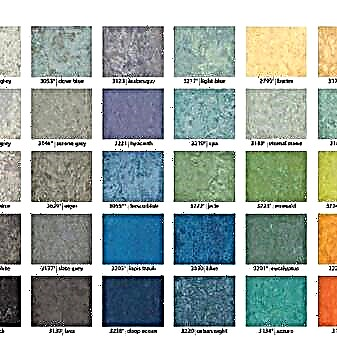

Errors made during repairs in the bathroom and toilet, see the next video

